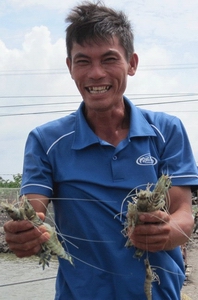
“I think taking legal proceedings is the best choice in this case. If we do not sue them, more and more countries would install barriers and raise the ethoxyquin barriers to higher levels, which makes Vietnam impossible to overcome them,” Quang said.
He complained that the technical barriers raised by importing countries have made the production costs of Vietnamese shrimp products much higher than that of other exporting countries.
Minh Phu Group, for example, has to pay tens of thousands of US dollars for every examination campaign.
“We have to spend 300 days out of the 365 days a year on receiving working groups who come to examine the production basis and give assessments,” Quang said.
“We have to spend at least one week for every inspection and assessment. Meanwhile, the productivity decreases by 50 percent on the assessment day, thus seriously affecting the production plan,” he added.
However, other exporters believe that Vietnam needs to think carefully before making any decision in such circumstances, saying that Vietnam should take legal proceedings against the unreasonable barrier if it can be sure that the move would have open the export markets. If not, the legal proceedings would not help Vietnam boost sales, but they would lead to the loss of the existing markets.
Minister of Agriculture and Rural Development Cao Duc Phat also keeps cautious when asked if Vietnam should take legal proceedings to ask to remove the barrier.
“Who will we sue and for what?” Phat said, adding that when trying to remove the ethoxyquin barrier, Vietnam should strive to sell more shrimps to the market, not to lose the market.
Truong Dinh Hoe, Secretary General of the Vietnam Association of Seafood Exporters and Producers (VASEP), agrees with Phat, saying that it is necessary to think twice before taking legal proceedings.
Hoe said that impatience would mess up the work. “On one hand, we should take necessary measures to minimize risks during the cultivation process, but on the other hand, we need to take diplomatic measures to request the Japanese side to adjust the requirements on ethoxyquin level,” Hoe said.
The ethoxyquin barrier has caused a serious headache to the Vietnamese seafood exporters.
In principle, Vietnam can boost exports to the EU and the US, the markets where ethoxyquin barrier does not exist. However, Vietnam would have to compete fiercely with the low cost shrimp products from India, Thailand and Malaysia. Meanwhile, it would face the ethoxyquin barrier when trying to enter South Korean or Japanese markets.
Quang of Minh Phu said South Korea on November 19, 2011, also began examining ethoxiquin in the imports from Vietnam.
The seafood exports to Japan have shrunk considerably since the day Japan raised the ethoxyquin barrier to 0.01 ppm.
VASEP hopes to obtain the shrimp export turnover of 2.4 billion dollars in 2013.





